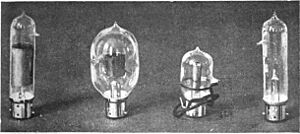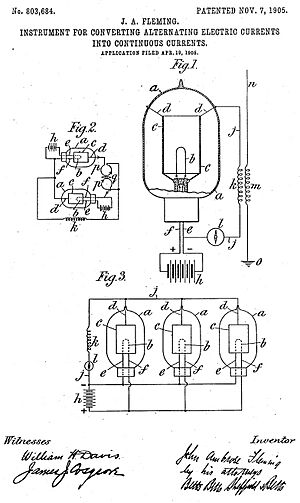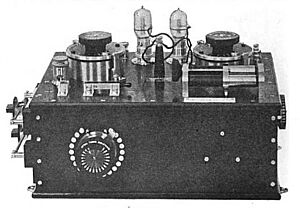Fleming valve facts for kids
The Fleming valve was an important electronic device invented in 1904 by a British scientist named John Ambrose Fleming. It was also called the Fleming oscillation valve. This device was a type of vacuum tube and was first used as a detector in early radio receivers. These radios helped send messages using radio waves.
The Fleming valve was the first useful vacuum tube and the first thermionic diode. A diode is a special tube that lets electricity flow in only one direction. This valve later became very important as a rectifier. A rectifier changes alternating current (AC) electricity, which changes direction, into direct current (DC) electricity, which flows in one steady direction. This was used in many electronic devices until newer parts like selenium and semiconductor diodes took over in the 1930s and 1960s. The Fleming valve was the start of all vacuum tubes, which were key to electronics for about 50 years!
Contents
How the Fleming Valve Works
The Fleming valve looks like a glass light bulb with all the air removed. Inside, it has two main parts called electrodes:
- A filament (like the glowing part in an old light bulb), which is the cathode. It's usually made of carbon or thin tungsten wire.
- A plate (a flat piece of metal or a metal cylinder), which is the anode.
To make the valve work, a small electric current flows through the filament, making it hot. When the filament gets hot enough, tiny particles called electrons jump off its surface into the empty space inside the tube. This process is called thermionic emission.
Now, imagine the radio signal you want to detect is connected to the filament and the plate.
- When the plate has a positive electrical charge compared to the filament, it pulls the electrons towards it. This creates an electric current that flows from the filament to the plate.
- But when the plate has a negative electrical charge, it pushes the electrons away. Since the plate itself doesn't release electrons, no current can flow through the tube in this direction.
Because electricity can only pass through the valve in one direction, it "rectifies" the changing AC signal into a pulsing DC signal. This allowed early radios to pick up and understand radio messages.
History of the Fleming Valve
The idea of electrons jumping off a hot metal surface (thermionic emission) was first noticed in 1873. Later, in 1880, Thomas Edison saw this effect while working on his light bulbs. He even got a patent for a device using it, but he didn't find a practical use for it. This became known as the Edison effect.
Professor Fleming worked for Edison's company and later for the Marconi Wireless Telegraph Company. In 1901, Fleming helped design the radio transmitter that Guglielmo Marconi used to send the first radio waves across the Atlantic Ocean. This amazing event sent signals from England to Canada, a distance of about 3,500 kilometers (2,175 miles). Even though it was a big step, the signal was very weak, and the radio receiver struggled to hear it clearly.
This made Fleming realize they needed a much better way to detect radio signals. In 1904, he tried using an Edison effect bulb for this purpose. He found that it worked very well to change high-frequency radio signals into a steady current that could be measured. On November 16, 1904, he applied for a patent for his "oscillation valve." This invention was quickly used by the Marconi company in their ship radios to detect Morse code messages. The Fleming valve was used until around 1916.
The Next Big Step: Amplifiers
The Fleming valve was just the beginning of a huge change in technology. In 1906, an American engineer named Lee de Forest read about Fleming's valve. De Forest then created a new vacuum tube called the Audion. He did this by adding a third part, a wire grid, between the filament and the plate.
This new device was the first electronic amplifier. An amplifier makes weak signals much stronger. This invention made it possible to create powerful amplifiers and devices that could make continuous radio waves. De Forest quickly improved his Audion into the triode. The triode became the foundation for long-distance telephone calls, radio communication, radar systems, and even early digital computers for 50 years! It wasn't until the 1960s that the transistor started to replace these vacuum tubes.
Powering Electronics
Later on, as electronic devices started to get their power from wall outlets instead of batteries, the Fleming valve was developed into a powerful rectifier. This was needed to change the AC electricity from the wall into the DC electricity that other vacuum tubes needed to work. Around 1914, a scientist named Irving Langmuir developed a high-voltage version called the Kenotron, which was used to power X-ray machines.
Until transistors took over in the 1970s, most radios and televisions had one or more diode tubes (like the Fleming valve) inside them to help power them.
See also
- Mercury rectifier





